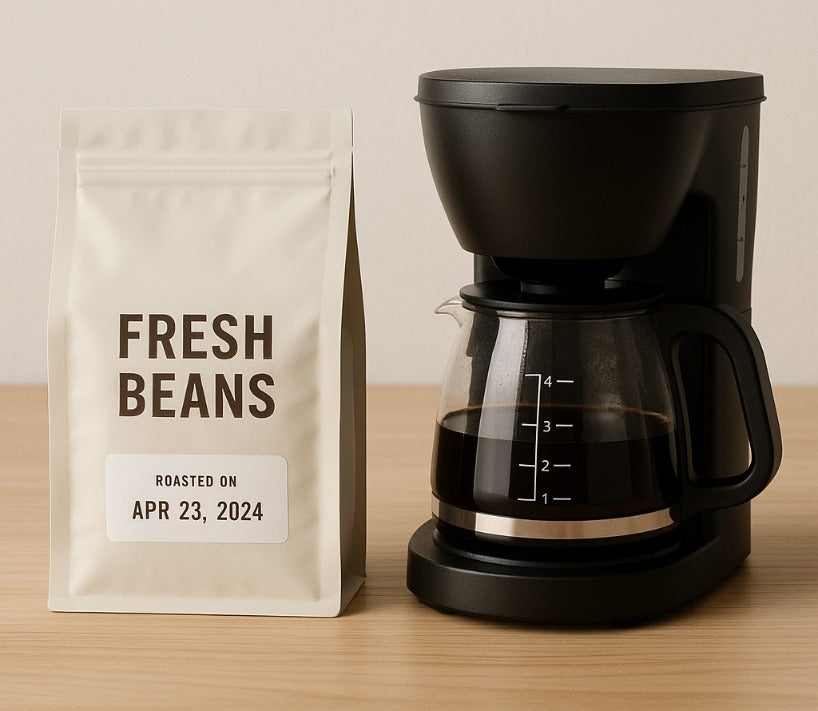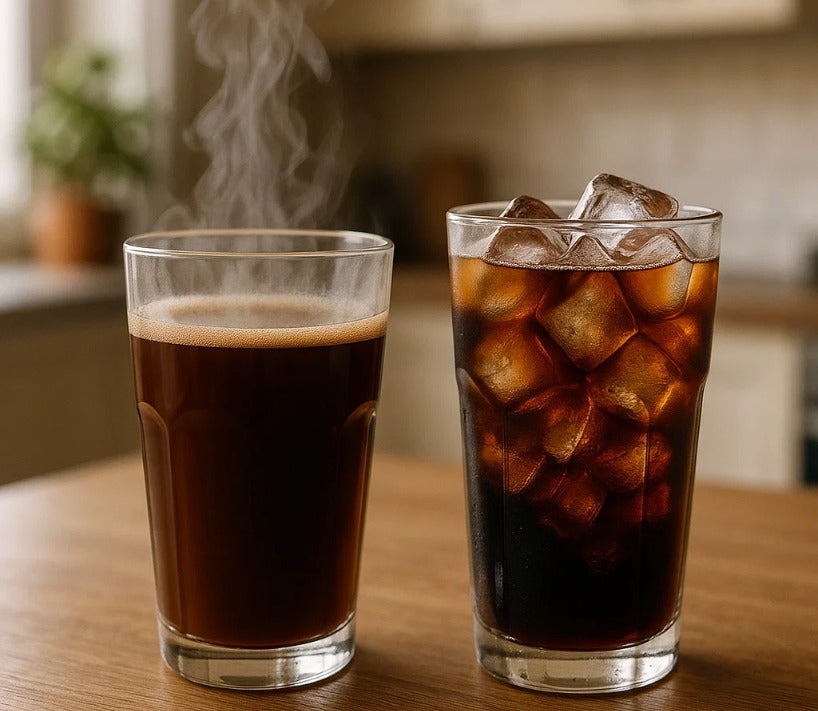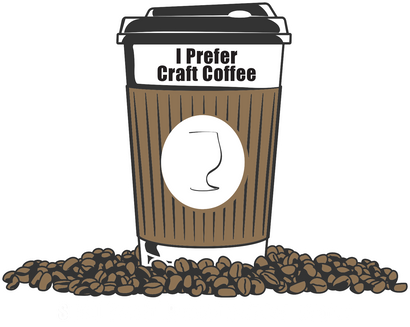Best Coffee To Buy Online: Why “Telephone Game” Beans Are the Worst Pick
June 11, 2025 4 min read
Best Coffee To Buy Online: Why “Telephone Game” Beans Are the Worst Pick
Wait… How Many Hands Just Touched My Coffee?
Remember the childhood telephone game? One kid whispers “purple pizza” and, ten ear-to-ear relays later, the class erupts at “pickled platypus.” Cute in grade school—catastrophic in your cup. The best coffee to buy online should taste like Colombia’s morning breeze, not a stale game of caffeine whisper-down-the-lane. Yet thousands of bags go out every day that have been ordered from Company A, roasted by Company B, labeled by Company C, then shipped by—heck, who even knows anymore? Somewhere between pickup and porch-drop, the beans develop an identity crisis.
Hi, I’m Andrew—owner, operator, roast-master, packer, resident comedian, and, yes, the guy sprinting to the post office. I’m here to spill the beans (literally) on why telephone-game coffee is the absolute worst and how to sidestep it so you always brew the best craft coffee at home—no middle-school game of whispers required.
The Ugly Truth Behind Telephone-Game Coffee
1. A Supply Chain Longer Than a CVS Receipt
Each additional handoff adds:
-
Time – Oxygen hangs out longer with the beans, dulling vibrant aromatics.
-
Cost – Everyone takes a slice of the pie, and you pay for crumbs.
-
Opacity – Tracking roast date? Good luck. By the time you get the bag, it’s been on more first dates than you in college.
2. Staleness Is Inevitable
Roasted coffee is a diva—fresh today, dramatic tomorrow, flat next week. A 2019 study showed detectable flavor loss after just 14 days post-roast (yes, that’s geeky but true). If Company A has to schedule a freight pickup from Company B before Company C slaps on postage, your “freshly roasted just for you” beans might be old enough to pay rent.
3. No One Owns the Result
With three companies sharing blame, guess how many accept responsibility when your pourover tastes like cardboard mousse? Exactly zero. The circle of finger-pointing begins.
Telephone-Game vs. Direct-From-Roaster: A Quick Comparison
Factor Telephone-Game Coffee Direct-From-Roaster Coffee (Andrew’s Way) Roast Date Transparency “Roasted fresh-ish… trust us.” Printed roast date, nerd-level accuracy Number of Hand-Offs 3–5 (sometimes more) 0 (unless Layla the shop dog counts) Flavor Integrity Fades during shipping relay Locked in within hours, arrives vivid Environmental Footprint Multiple facilities + extra packaging Single facility, minimal waste Support Local Craft Guess which business you’re helping… You’re helping this guy right here Side note: My table may be biased—I made it while gulping espresso I roasted an hour ago. But hey, I stand by the stats.
4. Marketing Labels = Smoke & Mirrors
Look for words like “hand-selected,” “artisan,” or “craft-roasted.” Sounds noble until you realize the “artisan” never actually saw your beans—the phrase is slapped on by a brand manager three states away.
5. The Flavor Telephone
-
Green Coffee Trader: “These beans have juicy mango and chocolate notes.”
-
Contract Roaster: “Mango… chocolate… sure, let’s highlight ‘sweet.’”
-
Wholesale Brand: “Sweet? Customers love candy. Let’s call it ‘cotton-candy sweetness.’”
-
Marketing Team: “Cotton candy reminds people of fairs. Let’s design a circus label!”
-
You (brewing at home): “Why does my mug taste like dusty peanuts?”
This is how “top specialty coffee online” transforms into a bland brew that even your office drip machine would reject.
How to Dodge the Telephone and Brew Like a Pro
Ask These Five Questions Before Clicking Add to Cart
-
“Who physically roasts my coffee?”
If the answer involves partners, facilities, or “our roasting network,” wave a white flag. -
“What’s the roast date going to be—specifically?”
Vague phrases like “fresh to order” often hide month-old stock. -
“How soon after roasting will it ship?”
The freshest craft coffee online typically ships within 24 hours of roasting—because flavors don’t wait for FedEx scheduling. -
“Can I speak to the roaster?”
Direct communication = accountability. If you can’t reach them, keep scrolling. -
“Do you publish cupping scores or tasting notes verified by a Q grader?”
This is the difference between genuine top specialty coffee online and marketing fan-fiction.
Trust Your Senses, Not Just the Label
-
Look for even bean color—mixed shades hint at sloppy batch blending.
-
Smell the bag as soon as it arrives—rich aromatics indicate recent roast.
-
Taste: If your coffee flavors spike, then die halfway through the cup, oxygen has already partied hard with your beans.
Embrace Single-Source Responsibility
When one person (hi again, it’s Andrew) controls green buying, roasting profile, cooling technique, degassing, packaging, and shipping, you get:
-
Consistency – Same roast curve every time.
-
Accountability – No one else to blame if your pour-over flops.
-
Community – You actually learn who roasted your caffeine lifeline, which makes bragging to friends way easier.
Freshness Timeline Cheat Sheet
| Post-Roast Day | Flavor Snapshot | Best Use |
|---|---|---|
| 1–3 | Beans are off-gassing CO₂; bright aromatics | Slow brew methods (Aeropress, pourover) |
| 4–10 | Peak balance of aromatics & sweetness | Anything—espresso shines here |
| 11–20 | Gradual flavor flattening | Milk drinks, cold brew |
| 30+ | Stale aromas, muted taste | Cold-brew concentrate or coffee-rub marinade |
Remember, telephone-game logistics can easily push you into that 11–20-day window before you ever tear open the box.
Make a Habit of Transparency Hunting
-
Check social feeds – Real roasters post actual roast footage, not stock photos of beans in mid-air.
-
Read customer reviews for freshness mentions – Look for “arrived warm” (yes, that’s a thing) or “roasted yesterday.”
-
Opt for “roasted-to-order” only if roast dates are printed – “Roasted-to-order” without a date is like saying “trust me, bro” during a home-inspection.
Final Sip
The moral of this caffeinated saga? The best coffee to buy online is never a product of corporate hot-potato. It’s the result of a single, accountable craftsperson obsessing over every step—from selecting green beans to heat-sealing the bag and slapping on the postage.
If you learn nothing else today, take this: Stop playing telephone with your taste buds. Demand transparency, chase roast dates, and pour yourself only the best coffee subscription online experience—or at least the freshest beans your burr grinder has ever met.
Now, excuse me while I don my shipping-clerk hat and sprint this afternoon’s roasts to the post office. The beans and I have a date with destiny… and a mailbox.
Also in Best Coffee To Buy Online Education

Best Tasting Coffee At Home: Stop Buying “Deals,” Start Buying Value
November 02, 2025 4 min read
Want the Best Tasting Coffee At Home? Skip old ‘deal’ beans. Use fresh, high-scoring, air-roasted coffee and a simple 1:16 plan. This guide shows proof, a clear promise, and a step-by-step plan to order smart, brew better, and enjoy sweeter, cleaner cups—daily.

Best Coffee To Make At Home: Fresh Beans, Simple Plan
October 31, 2025 4 min read
Learn the Best Coffee To Make At Home with a tiny, repeatable system: pick fresh, high-scoring, roast-to-order beans; brew at a simple 1:16 ratio; fix cups with one change at a time. Includes a comparison table, freshness rules, and beginner-friendly FAQs.

Best Coffee To Drink At Home: Hot or Cold?
October 30, 2025 4 min read
Use this quick Proof-Promise-Plan to choose the Best Coffee To Drink At Home—hot for bright aroma or cold for smooth sweetness. Get fresh-buying rules, grind and ratio maps, and a simple fix-it guide so your next cup tastes the way you like it.
